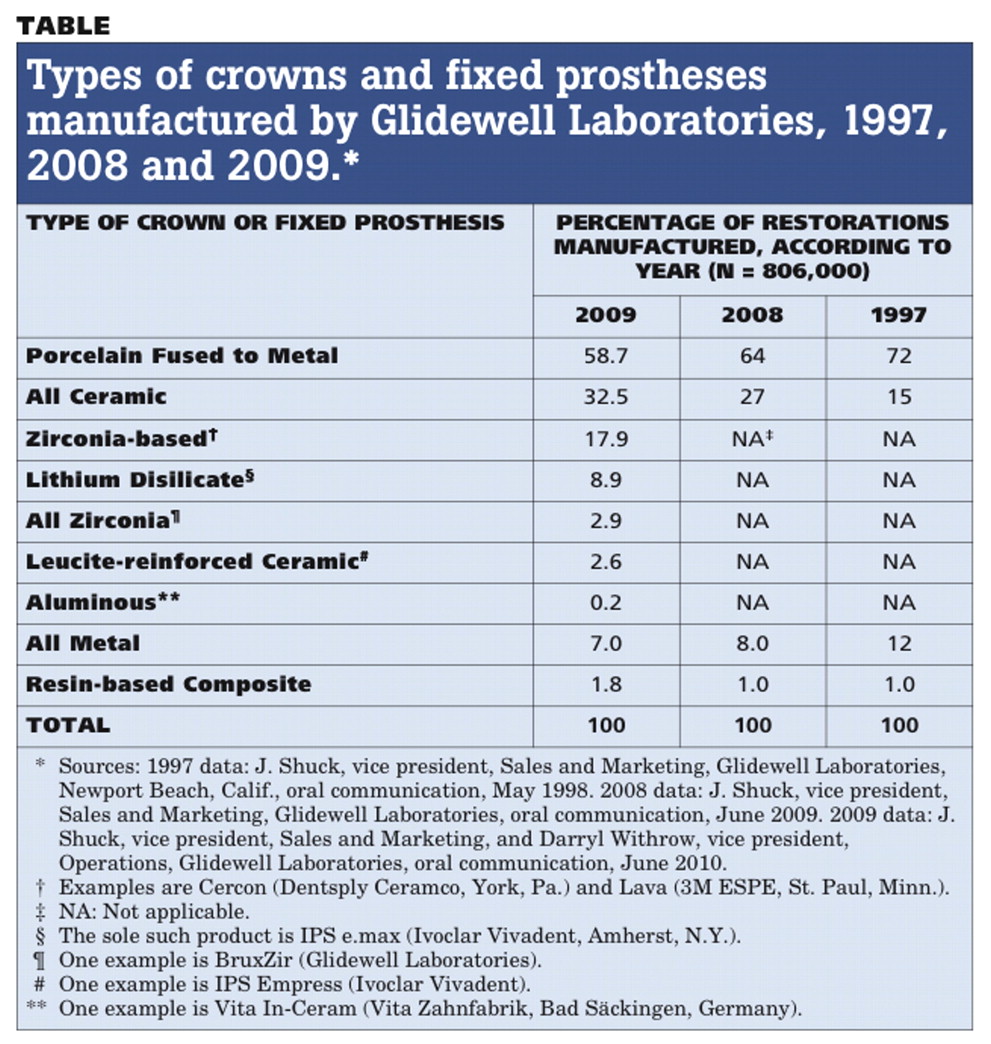CROWNS AND FIXED PROSTHESES: STATE OF THE ART
Porcelain-fused-to-metal restorations (PFM). After more than 50 years of successful clinical service and innumerable positive research findings regarding the clinical expectations for these restorations, dentists know and trust PFM restorations for single crowns and fixed prostheses. Research investigations show only a low percentage of failures after years of service in the mouth. PFM restorations have some well-known limitations:
- display of a chalky or metallic appearance at the gingival margins of the restoration when the gingiva recedes (this undesirable characteristic can be reduced by using ceramic margins);
- loss of superficial characterizing stains caused by acidic foods and beverages and the resultant change of the restoration to a lighter color than desirable;
- aggressive wear of opposing dentition or restorations (some ceramics are less aggressive than others);
- occasional chipping or fracture of ceramic from the metal substructure.
Many dentists consider PFM to be the standard of care for tooth-colored crowns and fixed prostheses. See tabl
e
Ceramic restorations. PFM still leads in use, but all-ceramic restorations are growing in popularity. Below is the list and advantages and disadvantages
Zirconia-based all-ceramic restorations. Most common uses. These restorations are being used for crowns and short fixed prostheses. Eg Cercon, Lava
Advantages. This material offers good esthetics, moderate strength and a history of nearly 10 years of clinical use with moderate success (ranging from excellent to poor).22
Disadvantages. The process of layering or pressing ceramic over zirconia still is being refined and improved; these restorations have a high cost.
Predictions for future use. Zirconia-based restorations and all-zirconia restorations are the only all-ceramic restorations with suitable strength for fixed pros-theses. Refinements in zirconia-based restorations are producing more predictability and clinical success than when they were introduced. Until and if all-zirconia restorations are proven in long-term service to compete with them, zirconia-based restorations will continue to grow in use instead of PFM restorations.
Lithium disilicate. Most common uses. Restorations of this material (IPS e-max, Ivoclar Vivadent, Amherst, N.Y.) are being used for single crowns, inlays and onlays made by laboratories or milled in the dental office.
Advantages. This material offers excellent esthetics, requires a relatively simple procedure to place, has moderate strength and can be used with conventional cements.
Disadvantages. This material can be used only for single-unit restorations; the concept still needs more clinical observation and research
Predictions for future use. The beauty of these restorations, as well as the widespread observation among clinicians that this material does not demonstrate significant breakage in single crowns, onlays and inlays, indicate the possibility for continued and expanded use.
Leucite-reinforced ceramic. Most common uses. This material (among the many brands of which is IPS Empress [Ivoclar Vivadent]) is being used for single crowns, inlays and onlays made in the laboratory or milled in the dental office.
Advantages. This material offers excellent esthetics and is chameleonlike in tooth matching.
Disadvantages. It has less strength than current all-ceramic crown materials; restorations must be bonded.
Predictions for future use. These beautiful restorations have been used for many years with relative success. However, I find that among the dentists in my continuing education courses, almost all of those who use leucite-reinforced restorations have experienced some failures. If lithium disilicate restorations prove themselves over the next few years for single-unit restorations, they undoubtedly will reduce the use of leucite-reinforced restorations.
All-ceramic. Most common uses. Although new and relatively unproven, these restorations are being used for single crowns and short-span fixed prostheses. (Among the many brands of this material is BruxZir, Glidewell Laboratories, Newport Beach, Calif.)
Advantages. This material offers strength, is monolithic (has no or minimal external layered ceramic) and leads to only minimal wear of opposing dentition.
Disadvantages. This material needs more clinical observation and scientific research to validate its long-term acceptability; it can be monotone and opaque, but improvements are being introduced; numerous clinical studies are in progress, but no published ones are yet available.
Predictions for future use. This material needs further research and long-term clinical observation. Until that time, I suggest that clinicians use it cautiously, but it appears to be a promising challenger.Metal (gold alloy) restorations. Most common uses. I have polled large groups of dentists concerning their feelings about use of cast gold alloy restorations, and as a group they are positive about the continuing long-term success and continued use of these restorations. The most accepted and promoted uses for all-metal full crowns are on first and second maxillary molars and mandibular first molars, as well as inlays and onlays on all posterior teeth.
Advantages. This material offers strength; low wear of opposing teeth; long-term service.
Disadvantages. This material has a high cost and a nonesthetic color. Tweet
Teeth Whitening Facts and Myths
Fiber reinforced composites in dentistry
Changing concepts in Class I and II cavity preparation
Latest Research On Dental Pain
Curing lights for composite resins
Fluorosis, epidemiology, indices and treatment
Lasers in Root canal treatment and Endodontics
Abfractions? How they are important in Restorative Dentistry
Caries Prevention in Children - The Indian Challenge
Mouth Rinsing before dental procedures.
Infection Control Routine for the Dental Clinic
Shade selection and Management
Obstructive Sleep Apnea- Do you know about it?
Genetically modified bacteria may prevent cavities - Put you out of Business?
A primer on all composite class materials
Options for esthetic restorations
Immediate and Early loading of Implants
Placement of gingival restorative margins
Bonding for the New Millennium
Access Cavity Preparation - Molars
Restoration of endodontic teeth
New cavity-fighting agent shows promise
Tooth Loss Linked to Pancreatic Cancer in Smokers
2-min brush helps achieve cleaner teeth: Study
Gum disease raises death risk in diabetics: study
Brushing Right After Drinking Soda may Harm Teeth
Benefits of Pre-procedural mouth rinsing?
To Bond Or not to Bond Amalgam